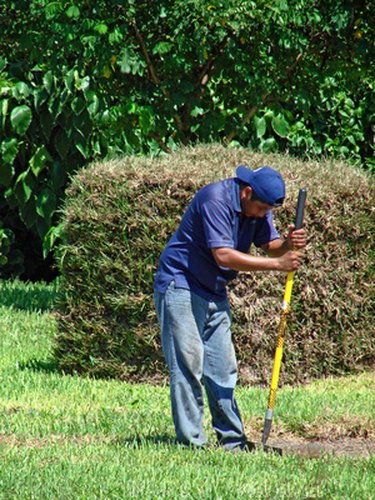Things You'll Need
5-pound hand sledge hammer
Layout stakes
Mason's cord or heavy twine
Trenching shovel
Schedule 40 PVC electrical conduit
PVC conduit couplings
PVC factory 90s
PVC pipe cutter
PVC pipe primer/cleaner
PVC pipe cement

Installing an underground electrical Polyvinyl chloride conduit is straightforward project. Working with PVC conduit is easy and requires few special tools compared to working with steel electrical conduit. The only difficult part is digging the trench to bury it in; the trenching can be labor intensive. You may, depending on the length of the trench to be dug and on the soil conditions, want to rent a power trencher for this portion of the project.
Step 1
Apply for an electrical permit from your municipality's building permits department before beginning the installation. You should also contact telephone, cable, and power utilities to mark out the location of any underground cables, gas lines and water lines. They will send a technician out to mark those locations for you at no cost to you. Do not begin work until you have the permit and have posted it at the work site.
Video of the Day
Step 2
Layout the route, the underground electrical conduit is to follow by drive stakes into the ground at 10 foot intervals and connect the stakes together using Mason's cord or heavy twine. Marking out the route the conduit will take in this manner is crucial. It is remarkably easy to stray to one side or the other of the desired path when digging a trench. Do not mark both sides of the trench because it will be difficult working between the lines.
Step 3
Dig a trench that is at least 24 inches deep, and 12 inches wide. The National Electrical Code requires that underground PVC conduit be covered by at least 18 inches of dirt when installed on private property (National Electrical Code Table 300-5).
Step 4
Lay the PVC conduit beside the trench and cut the final piece to length using the PVC pipe cutter. You can cut PVC with any kind of saw if you do not have a PVC pipe cutter but using a PVC pipe cutter assures you of getting a square cut which is essential for making a good joint between the conduits.
Step 5
Place the conduit in the trench and join them together, end to end using the PVC couplings. Coat the outside of the adjoining ends of two conduits with PVC cleaner/primer and the inside of one coupling with cleaner/primer. While the PVC cleaner/primer is still wet, apply a liberal coating of PVC cement in the same manner. Slip the ends of the conduits into the coupling until they touch in the middle of the coupling. Twist the joint back and forth several time and then let it set for 2 to 3 minutes before moving on to the next joint.
Step 6
Join the factory 90s to both ends using the PVC cleaner/primer and the PVC cement. Attach short lengths of PVC conduit to each factory 90 so it will end 12 inches above ground level when the trench is filled in.
Step 7
Call the building department and request the required inspection. After the inspector gives your work approval, you can fill in your trench.
Warning
Never perform any electrical work without getting the appropriate permits from the building department and always have the required inspections performed on your work. Failure to do so not only carries a steep fine if you are caught, non-inspected work can cause your homeowner's insurance to be canceled.
Video of the Day